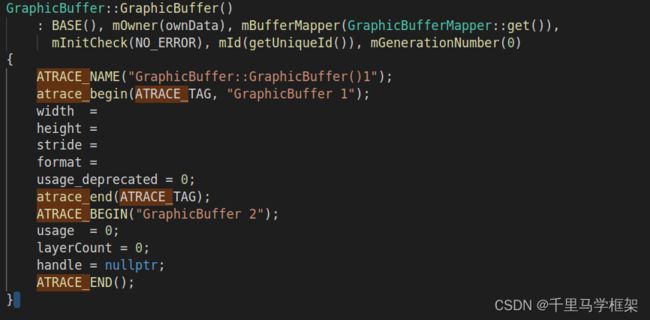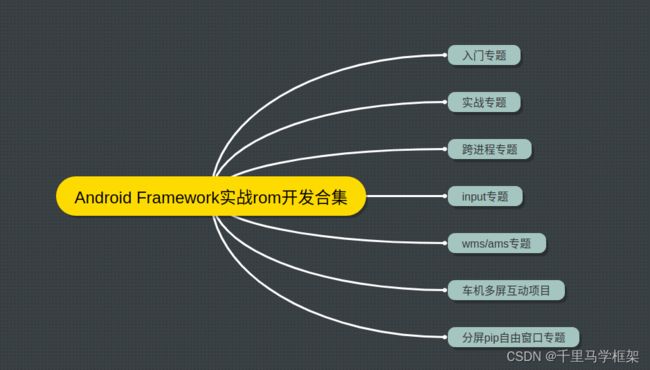systrace/perfetto中需要actrace打tag相关方法-车载车机framework系统开发实战
背景:
经常在看systrace、perfetto相关trace时候,其实我们主要就是看各种方法的调用tag,如下图所示
 正因为有了系统中各个地方埋下的这些tag,才让我们可以根据这些方法tag分析出整个系统的运行情况。但是大家有没有想过,请问这些tag是怎么打上去的?如果我们自己要打印自己方法的tag应该怎么搞?
正因为有了系统中各个地方埋下的这些tag,才让我们可以根据这些方法tag分析出整个系统的运行情况。但是大家有没有想过,请问这些tag是怎么打上去的?如果我们自己要打印自己方法的tag应该怎么搞?
使用atrace相关类方法介绍
这里还需要看对应的trace源码是最全面的
路径:system/core/libcutils/include/cutils/trace.h
源码:
/*
* Copyright (C) 2012 The Android Open Source Project
*
* Licensed under the Apache License, Version 2.0 (the "License");
* you may not use this file except in compliance with the License.
* You may obtain a copy of the License at
*
* http://www.apache.org/licenses/LICENSE-2.0
*
* Unless required by applicable law or agreed to in writing, software
* distributed under the License is distributed on an "AS IS" BASIS,
* WITHOUT WARRANTIES OR CONDITIONS OF ANY KIND, either express or implied.
* See the License for the specific language governing permissions and
* limitations under the License.
*/
#ifndef _LIBS_CUTILS_TRACE_H
#define _LIBS_CUTILS_TRACE_H
#include 日常使用trace打TAG其实本质上都是基于这个类的,在这个的基础上会加一些额外包装
比如常见的几个方法:
1、ATRACE_CALL();
这个方法,代表对一个function的开头和结尾进行tag,它的源码如下
#define ATRACE_CALL() ATRACE_NAME(FUNCTION)
即本质调用的是ATRACE_NAME
2、ATRACE_NAME方法
这个方法的本质定义如下
//这里的ATRACE_NAME其实本质是个临时对象构造和析构进行调用的atrace_begin和atrace_end,这两个其实就是trace.h原始方法
#define ATRACE_NAME(name) ::android::ScopedTrace PASTE(___tracer, __LINE__)(ATRACE_TAG, name)
namespace android {
//临时对象,调用该时候该对象刚好构造,一般方法域结束就代表作用无效了,因为会进行对象的析构
class ScopedTrace {
public:
inline ScopedTrace(uint64_t tag, const char* name) : mTag(tag) {
atrace_begin(mTag, name);//构造时候进行begin
}
inline ~ScopedTrace() {
atrace_end(mTag);//析构时候代表trace结束end
}
private:
uint64_t mTag;
};
调用如下:

效果如下:

其他常见还有
3、ATRACE_INT
具体源码:
/**
* Traces an integer counter value. name is used to identify the counter.
* This can be used to track how a value changes over time.
*/
#define ATRACE_INT(name, value) atrace_int(ATRACE_TAG, name, value)
static inline void atrace_int(uint64_t tag, const char* name, int32_t value)
{
if (CC_UNLIKELY(atrace_is_tag_enabled(tag))) {
void atrace_int_body(const char*, int32_t);
atrace_int_body(name, value);
}
}
trace相关实战使用:
1、引入相关的头文件及相关库
#include
编译时候还得考率相关utils的lib是否引入
如这里以截图代码为例就有引入libutils
frameworks/base/cmds/screencap/Android.bp
cc_binary {
name: "screencap",
srcs: ["screencap.cpp"],
shared_libs: [
"libcutils",
"libutils",
"libbinder",
"libjnigraphics",
"libui",
"libgui",
],
cflags: [
"-Wall",
"-Werror",
"-Wunused",
"-Wunreachable-code",
],
}
2、定义好相关的TAG
#undef ATRACE_TAG
#define ATRACE_TAG ATRACE_TAG_GRAPHICS
这里就选了一个ATRACE_TAG_GRAPHICS即graphics这个组
3、调用相关actrace方法
ATRACE_CALL
ATRACE_NAME
一般针对整个方法或者单独作用域,ATRACE_CALL和ATRACE_NAME本质没有区别,只是把名字变成了function的name
 具体效果如下:
具体效果如下:
![]() 优点:只需要一个调用既可以实现tag打印,自动跟随作用域进行tag的结束
优点:只需要一个调用既可以实现tag打印,自动跟随作用域进行tag的结束
缺点:需要自己熟练掌握好作用域,没有可以手动控制的tag结束的点
4、相关灵活控制开始与结束的trace方法
直接使用atrace_begin和atrace_end方法,使用如下:
GraphicBuffer::GraphicBuffer()
: BASE(), mOwner(ownData), mBufferMapper(GraphicBufferMapper::get()),
mInitCheck(NO_ERROR), mId(getUniqueId()), mGenerationNumber(0)
{
ATRACE_NAME("GraphicBuffer::GraphicBuffer()1");
atrace_begin(ATRACE_TAG, "GraphicBuffer 1");
width =
height =
stride =
format =
usage_deprecated = 0;
atrace_end(ATRACE_TAG);
usage = 0;
layerCount = 0;
handle = nullptr;
}
具体效果如下:

同时也可以使用对应宏定义:
ATRACE_BEGIN(name);
ATRACE_END();
来控制

执行后效果如下:

更多framework干货手把手教学视频及答疑可以看这里,可以加我v(androidframework007)获取:

https://blog.csdn.net/learnframework/article/details/132739059


